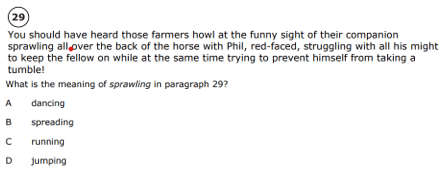What do we call parts of text that support our answer choices?
Text Evidence
What is central message/moral?
the lesson the characters or the reader learns from reading the story. (don't lie, be brave, work hard, etc.)
What is it called when two characters are talking to each other?
Dialogue
What does sequence mean?
in the order it happened or should happen
DOUBLE points if you can tell me what each of the 5 types mean!!
Inference, Definition, Example, Antonym, Synonym
How many times should we read a passage before answering questions about it?
At least 3
How can we show that we found our answer in the text?
By highlighting and marking the highlighted portion with the number of the question it helped us answer.
How can you find the main idea?
Look at the title, headings, pictures.
Look in the first and last sentence.
Look for clue words used repeatedly.
How do authors show us that dialogue is being used in text?
By using quotation marks " " or sometimes italicizing words
To see how things are alike/similar or different
What does it mean to infer?
using what you already know or past experiences AND evidence from the text to make logical guess.
Example: Sheila didn't get the last spot on the volleyball team.
Based on how I know I would feel in that situation, I can infer that Sheila was sad about not making it on the team.
What is a good strategy for taking reading tests?
Read the questions and answer choices first before reading the passage. This will help you know what to look for when reading a passage.
Which answer choice best supports the main idea?
What does it mean to support?
the information that helps prove, explain, or clarify what the question is about.
What is the plot of a story?
what happens in a story (problem/solution)
"What motivated the chicken to run across the road?"
What are character motivations? What does motivate mean?
the reasons why a character acts (does something), thinks, or feels a certain way
What is author's purpose?
Why the author wrote a text: was it to inform? persuade? or to entertain the reader?
What is the literal meaning of a word or phrase?
What the word actually means; the normal, basic, everyday meaning of a word.
What are clue words for cause/effect?
because, so, since, as a result, therefore, this lead to, consequently
What is the setting in a story?
What the story is mostly about
What has to happen BEFORE the effect?
What are at least 2 clue words for contrasting?
different, unlike, however, in contrast, on the other hand, but, contrary, though/although, whereas
What is non literal or figurative language?
When words or phrases mean something other than exactly what it says.
Examples: My aunt has a beautiful garden. She definitely has a green thumb!
Dancing stars filled the sky.
First, next, then, last, finally, after, before
Dates and times can also be used.
What is a character?
A person or animal in the story
What message was the author trying to convey to the reader?
What does it mean to convey?
to make known, show, or communicate
How did the character's actions contribute to the ending of the story?
What does contribute mean?
to add to or cause other things to happen
What are context clues? How do they help the reader?
information provided in the text that helps the reader understand the meaning of new or unknown words
What is one trick Mrs. Potter taught you to help you determine the meaning of new or unknown words/phrases?
"Plug" the options in place of the word in the text to see what makes sense. 
How are the ideas in paragraphs 3 and 4 connected?
What does connected mean?
How do they go together, is it talking about a cause and effect? Is the information giving you a problem and a solution? Is there sequencing involved?
This question is asking the reader how the information in the text is presented: compare/contrast, cause/effect, sequencing, problem/solution, describing